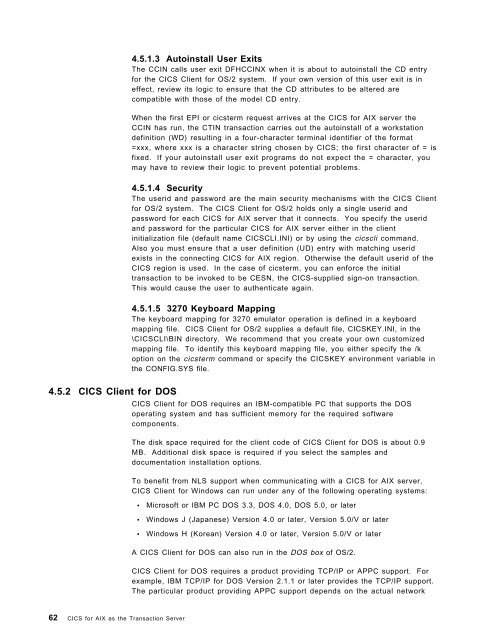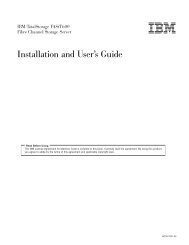Addressing OLTP Solutions with CICS: The Transaction Server ... - Ibm
Addressing OLTP Solutions with CICS: The Transaction Server ... - Ibm
Addressing OLTP Solutions with CICS: The Transaction Server ... - Ibm
Create successful ePaper yourself
Turn your PDF publications into a flip-book with our unique Google optimized e-Paper software.
4.5.2 <strong>CICS</strong> Client for DOS<br />
62 <strong>CICS</strong> for AIX as the <strong>Transaction</strong> <strong>Server</strong><br />
4.5.1.3 Autoinstall User Exits<br />
<strong>The</strong> CCIN calls user exit DFHCCINX when it is about to autoinstall the CD entry<br />
for the <strong>CICS</strong> Client for OS/2 system. If your own version of this user exit is in<br />
effect, review its logic to ensure that the CD attributes to be altered are<br />
compatible <strong>with</strong> those of the model CD entry.<br />
When the first EPI or cicsterm request arrives at the <strong>CICS</strong> for AIX server the<br />
CCIN has run, the CTIN transaction carries out the autoinstall of a workstation<br />
definition (WD) resulting in a four-character terminal identifier of the format<br />
=xxx, where xxx is a character string chosen by <strong>CICS</strong>; the first character of = is<br />
fixed. If your autoinstall user exit programs do not expect the = character, you<br />
may have to review their logic to prevent potential problems.<br />
4.5.1.4 Security<br />
<strong>The</strong> userid and password are the main security mechanisms <strong>with</strong> the <strong>CICS</strong> Client<br />
for OS/2 system. <strong>The</strong> <strong>CICS</strong> Client for OS/2 holds only a single userid and<br />
password for each <strong>CICS</strong> for AIX server that it connects. You specify the userid<br />
and password for the particular <strong>CICS</strong> for AIX server either in the client<br />
initialization file (default name <strong>CICS</strong>CLI.INI) or by using the cicscli command.<br />
Also you must ensure that a user definition (UD) entry <strong>with</strong> matching userid<br />
exists in the connecting <strong>CICS</strong> for AIX region. Otherwise the default userid of the<br />
<strong>CICS</strong> region is used. In the case of cicsterm, you can enforce the initial<br />
transaction to be invoked to be CESN, the <strong>CICS</strong>-supplied sign-on transaction.<br />
This would cause the user to authenticate again.<br />
4.5.1.5 3270 Keyboard Mapping<br />
<strong>The</strong> keyboard mapping for 3270 emulator operation is defined in a keyboard<br />
mapping file. <strong>CICS</strong> Client for OS/2 supplies a default file, <strong>CICS</strong>KEY.INI, in the<br />
\<strong>CICS</strong>CLI\BIN directory. We recommend that you create your own customized<br />
mapping file. To identify this keyboard mapping file, you either specify the /k<br />
option on the cicsterm command or specify the <strong>CICS</strong>KEY environment variable in<br />
the CONFIG.SYS file.<br />
<strong>CICS</strong> Client for DOS requires an IBM-compatible PC that supports the DOS<br />
operating system and has sufficient memory for the required software<br />
components.<br />
<strong>The</strong> disk space required for the client code of <strong>CICS</strong> Client for DOS is about 0.9<br />
MB. Additional disk space is required if you select the samples and<br />
documentation installation options.<br />
To benefit from NLS support when communicating <strong>with</strong> a <strong>CICS</strong> for AIX server,<br />
<strong>CICS</strong> Client for Windows can run under any of the following operating systems:<br />
• Microsoft or IBM PC DOS 3.3, DOS 4.0, DOS 5.0, or later<br />
• Windows J (Japanese) Version 4.0 or later, Version 5.0/V or later<br />
• Windows H (Korean) Version 4.0 or later, Version 5.0/V or later<br />
A <strong>CICS</strong> Client for DOS can also run in the DOS box of OS/2.<br />
<strong>CICS</strong> Client for DOS requires a product providing TCP/IP or APPC support. For<br />
example, IBM TCP/IP for DOS Version 2.1.1 or later provides the TCP/IP support.<br />
<strong>The</strong> particular product providing APPC support depends on the actual network
















